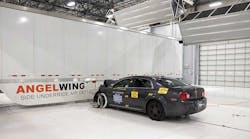Underride guard testing at the Insurance Institute for Highway Safety has taken a 90-degree turn. After evaluating rear underride guards for several years, the Institute has turned its attention to side underride protection.
IIHS conducted two crash tests in March—the first time the Institute has done so. The methodology was similar to the rear underride tests that the Institute has conducted the past several years. As was the case when the Institute tested rear underride guards, identical Chevrolet Malibu automobiles crashed into the trailer at 35 mph. One of the tests involved a trailer equipped only with generic trailer skirts. In the second test, the trailer also had side skirts, but the skirts were backed up by a guard specifically designed to protect against side impacts by automobiles. The side underride guard was manufactured by AirFlow Deflector Inc.
In both tests, a midsize car struck the center of a 53-foot-long dry van trailer. In the test involving the side underride guard, the guard bent but didn’t allow the car to go underneath the trailer. The car’s airbags inflated as designed, and the safety belt properly restrained the test dummy in the driver seat.
In the second test with no underride guard for protection, the car ran into the trailer and kept going. The impact sheared off part of the roof, and the sedan became wedged beneath the trailer. In a real-world crash like this, any occupants in the car would likely sustain fatal injuries, according to IIHS.
The test program follows an analysis of car and truck crash data. A 2012 IIHS study concluded that strong side underride guards have the potential to reduce injury risk in about 75% of large truck side crashes producing a fatality or serious injury to a passenger vehicle occupant. IIHS says this proportion increases to almost 90 percent when restricted to crashes with semitrailers. That’s due in part to the greater length of trailers, says David Zuby, executive vice president and chief research officer at IIHS. The wheels on a tractor and trailer offer some underride protection if a passenger vehicle were to strike them. With no side underride guard, only 28 percent of a 53-foot trailer’s length would be protected from underride. The AngelWing side underride guard protected 62 percent of the trailer’s length.
IIHS says that fatalities from side collisions are more common than those resulting when a passenger car strikes the rear of the trailer. In 2015, 301 of the 1,542 passenger vehicle occupants killed in two-vehicle crashes with a tractor-trailer died when their vehicles struck the side of a tractor-trailer. This compares with the 292 people who died when their passenger vehicles struck the rear of a tractor trailer.
“Our tests and research show that side underride guards have the potential to save lives,” Zuby says. “We think a mandate for side underride guards on large trucks has merit, especially as crash deaths continue to rise on our roads.
“We are not ready to petition the National Highway Traffic Safety Administration for rulemaking, but we will share our findings with regulators when they are complete. Right now we want fleets to be aware of the safety benefits of side underride guards.”
To date, the only guard IIHS has tested is the AngelWing manufactured by Airflow Deflector Inc.
“We know other companies are working on this and would be interested in testing other guards as well,” Zuby says.









